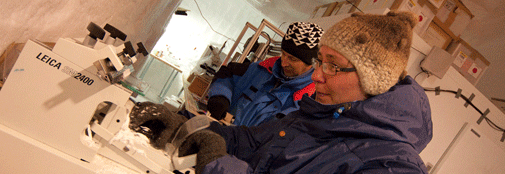Studying the physical properties of ice

Ilka and Jerome are preparing thin sections of ice for ice crystal studies.
Ice core climate records such as temperature proxies, past greenhouse gas concentrations and the impurity content of the ice are the main focus of ice core studies. Besides those, a whole range of properties of the ice itself are also being investigated and a section of the ice core is dedicated to those analyses.
An example is the study of ice crystal dynamics, i.e. how ice sheet ice crystals form, grow, deform, interact and orient themselves as ice layers sink into the ice sheet. The ice crystal information helps to determine the ice flow at the drilling site, which again is applied in ice sheet models to learn how ice sheets react to climate change. Ice crystal studies are also used to investigate how well the ice core stratigraphy is preserved in the deepest part of the core. Another study is concerned with the transformation of snow into firn and the compression of firn into ice. In this process the air bubbles are formed and a thorough understanding of this mechanism is needed in order to make the proper interpretation of the Greenhouse gas records.
At NEEM the ice core physical property studies take place in the deepest part of the science trench, in 'Sepp's Cave', where little ice samples are studied in great detail by microscopes, scanners and fabric analyzers. There is still a lot to be learned about one of the most common materials on Earth.
Drilling: 11.65 m, drillers depth: 2342.36 m.
Logging: 12.72 m, loggers depth: 2358.68 m.
Processing: bag 4178-4217 (22.00 m) 2319.35 m.
CFA: bag 3516-3545 (16.50 m) 1949.75 m.
What we have done today:
1. Drilling and core logging ice.
2. Processed deep ice cores.
3. CFA measurements.
4. Cleaned up camp for computer viruses.
5. Enjoyed a lovely German dinner with an Ecuadorian touch.
Weather: Just like yesterday, it has been a beautiful day with clear blue sky, low winds (8 kn) from S and temperatures -18 °C to -6 °C.
FL's Dorthe Dahl-Jensen and Anders Svensson
| ← Previous entry | Next entry → |

